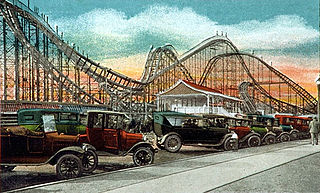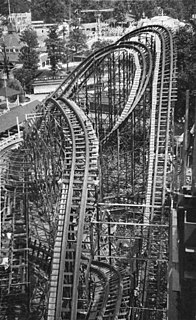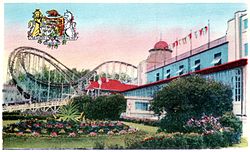
A roller coaster, or rollercoaster, is a type of amusement ride that employs a form of elevated railroad track designed with tight turns, steep slopes, and sometimes inversions. Passengers ride along the track in open cars, and the rides are often found in amusement parks and theme parks around the world. LaMarcus Adna Thompson obtained one of the first known patents for a roller coaster design in 1885, related to the Switchback Railway that opened a year earlier at Coney Island. The track in a coaster design does not necessarily have to be a complete circuit, as shuttle roller coasters demonstrate. Most roller coasters have multiple cars in which passengers sit and are restrained. Two or more cars hooked together are called a train. Some roller coasters, notably Wild Mouse roller coasters, run with single cars.

The Big One, formerly known as the Pepsi Max Big One, is a steel roller coaster located at Blackpool Pleasure Beach in Blackpool, Lancashire, United Kingdom. Designed by Ron Toomer and manufactured by Arrow Dynamics, the ride opened to the public on 28 May 1994 as the tallest and steepest roller coaster in the world. It held the record until July 1996, when Fujiyama opened at Fuji-Q Highland in Japan. The ride is currently the tallest roller coaster in the United Kingdom.

Out and back refers to the layout of a roller coaster. An out and back coaster is one that climbs a lift hill soon after leaving the station, races out to the far end of the track after the initial drop, performs a 180 degree turn and then returns to the station. Some out and back coasters perform more complicated turns at the far end of the track.

Twisted Cyclone, formerly known as Georgia Cyclone, is a steel roller coaster located at Six Flags Over Georgia in Austell, Georgia. Manufactured by Rocky Mountain Construction (RMC), the ride opened to the public on May 25, 2018. It features RMC's patented I-Box Track technology and utilizes a significant portion of Georgia Cyclone's former support structure. Originally constructed by the Dinn Corporation, Georgia Cyclone first opened on March 3, 1990.

American Eagle is a wooden racing roller coaster located at Six Flags Great America theme park in Gurnee, Illinois. It was the first wooden roller coaster designed by Intamin of Switzerland and was built in 1981 by the contracting firm Figley-Wright at a cost of $10 million. While most of the records have since been broken, American Eagle had the longest drop and fastest speeds among wooden roller coasters when it debuted and is still recognized as a top racing coaster in the United States.

The Bat was a suspended roller coaster located at Kings Island amusement park in Mason, Ohio. Designed by Arrow Development, it was billed as the "first of its kind" in the world when it opened to the public on April 26, 1981. The suspended coaster concept was a radical departure from traditional roller coaster design, where guests ride below the track instead of above. Previous attempts to build coasters that hang from the track were unsuccessful and date as far back as the early 20th century. Arrow solved issues by utilizing modern technology in the design, including its tubular steel track developed in 1959 for Disneyland's Matterhorn Bobsleds.
Harry Guy Traver was an American engineer and early roller coaster designer. As the founder of the Traver Engineering Company, Traver was responsible for the production of gentle amusement rides like the Tumble Bug and Auto Ride. However, Traver's coasters became legendary for their unique twisted layouts and thrilling, swooped turns. At a time when most coasters were built from wood, Traver was the first coaster builder to utilize steel for the primary structural material.

The Wild Mouse was a wooden roller coaster located in Blackpool Pleasure Beach which opened in 1958. It was one of only four remaining wooden Wild Mouse coasters left in the world as of the end of the 2017 season, and was held in very high regard as one of the finest and most extreme examples of Wild Mouse coasters.

The Silver Comet is a wooden roller coaster with a hybrid steel frame at Niagara Amusement Park & Splash World in Grand Island, New York.
Roller coaster elements are the individual parts of roller coaster design and operation, such as a track, hill, loop, or turn. Variations in normal track movement that add thrill or excitement to the ride are often called "thrill elements".

The Gold Coaster is a steel roller coaster operating at Dreamworld. The roller coaster is one of the tallest in the Southern Hemisphere, after originally being the tallest when it was first built. Designed by Arrow Dynamics, built in Melbourne by Able Leisure Pty. Ltd the ride was originally installed at Luna Park Sydney in 1995 as the Big Dipper before being sold and relocated to Dreamworld on the Gold Coast in 2001. When it was brought to Dreamworld, the ride was the first roller coaster to be opened on the Gold Coast since 1997. The roller coaster was named Cyclone from 2001 until 2015 when it was refurbished and named Hot Wheels SideWinder as part of the new Motorsport Experience themed land from 2015 to 2020.

Avalanche is a steel bobsled roller coaster at Blackpool Pleasure Beach in Blackpool, England. It is the first and, as of 2022, the only bobsled roller coaster in the United Kingdom. It was designed for the park by Mack of Germany in 1988.
La Broca opened in 1997 in Montenegro, Quindio, Colombia as Parque del Café's first roller coaster. The original ride opened in 1973 and stood for 25 seasons at Worlds of Fun, which at the time was the longest-standing coaster in the park's history . It is one of only two Schwarzkopf Speed Racer models still in operation today; the other is Whizzer at Six Flags Great America in Gurnee, Illinois. The site where Zambezi Zinger once stood is now occupied by Boomerang. The ride was unusual as it did not have seatbelts or any lap bar restraint.

Roller Coaster – also known as Scenic Railway or The Scenic – is a wooden roller coaster at Great Yarmouth Pleasure Beach, Great Yarmouth, UK. The ride was built at the park in 1932 and has been operational since. It is one of only two scenic railways still in operation in the UK and one of only seven in the world. In common with most scenic railways, an operator rides the car. Traditionally referred to as a 'brakeman’, the operator applies brakes on the car to control its speed and to stop it at the end of the ride, as there are no brakes on the track. It is the second tallest and second fastest wooden roller coaster in the UK. It is also a Grade II listed building.

Lightning was a wooden roller coaster that operated from 1927 until 1933 at Revere Beach in Revere, Massachusetts. It was one of the infamous Giant Cyclone Safety Coasters which were constructed by noted roller coaster engineer Harry G. Traver in the mid-1920s. Lightning was the only Giant Cyclone Safety Coaster not to bear the "Cyclone" name, as a roller coaster named Cyclone already existed at Revere Beach when Lightning was constructed in 1927. The other two members of this group of coasters included the Crystal Beach Cyclone and the Palisades Park Cyclone.

The Great White is a sit-down wooden/steel roller coaster made and built by Custom Coasters International.

The Sesquicentennial Cyclone was a steel-framed wooden roller coaster which was operated at the Philadelphia Sesquicentennial Exposition in 1926. Designed and built by Harry Traver of Traver Engineering, the coaster was a medium-sized prototype of Traver's later Giant Cyclone Safety Coasters.

Cyclone was the name of two wooden roller coasters which operated at Palisades Amusement Park in Bergen County, New Jersey, United States. The first operated from 1927 through 1934, and the second between 1945 and 1971.
Zip or Zipp was a steel-framed wooden roller coaster which operated at Oaks Amusement Park in Portland, Oregon. The coaster was a more compact variant of the Giant Cyclone Safety Coasters which were built by Harry Traver of the Traver Engineering Company in the mid to late 1920s.
Giant Cyclone Safety Coasters were a model line of roller coasters designed and marketed by Harry Traver and his company Traver Engineering in the 1920s. Despite their name, they had a reputation of being dangerous and are regarded by many historians as some of the most fearsome roller coasters ever built.















